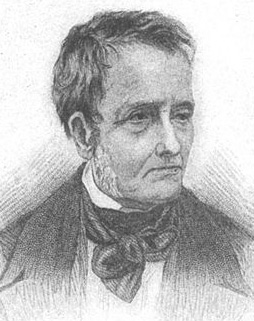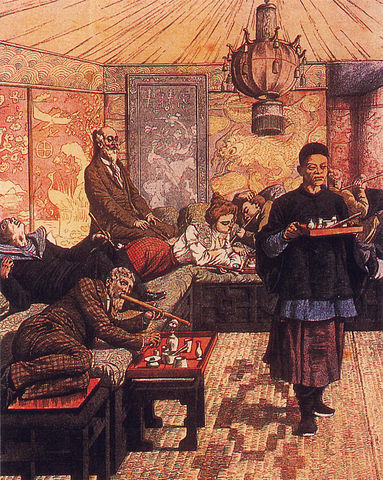
By Robert Morrison
In The Metaphysics of Morals (1797), Immanuel Kant gives the standard eighteenth-century line on opium. Its “dreamy euphoria,” he declares, makes one “taciturn, withdrawn, and uncommunicative,” and it is “therefore… permitted only as a medicine.” Eighty-five years later, in The Gay Science (1882), Friedrich Nietzsche too discusses drugs, but he has a very different story to tell. “Who will ever relate the whole history of narcotica?” he asks pointedly. “It is almost the history of ‘culture’, of so-called high culture.” What caused this seismic shift in attitude? How did opium, in less than a century, pass from a drug understood primarily as a medicine to a drug used and abused recreationally, not just in “high culture”, but across the social strata?
 The short answer is Thomas De Quincey. In his Confessions of an English Opium-Eater, first published in the London Magazine for September and October 1821, he transformed our perception of drugs. De Quincey invented recreational drug-taking, not because he was the first to swallow opiates for non-medical reasons (he was hardly that), but because he was the first to commemorate his drug experience in a compelling narrative that was consciously aimed at — and consumed by — a broad commercial audience. Further, in knitting together intellectualism, unconventionality, drugs, and the city, De Quincey mapped in the counter-cultural figure of the bohemian. He was also the first flâneur, high and anonymous, graceful and detached, strolling through crowded urban sprawls trying to decipher the spectacles, faces, and memories that reside there. Most strikingly, as the self-proclaimed “Pope” of “the true church on the subject of opium,” he initiated the tradition of the literature of intoxication with his portrait of the addict as a young man. De Quincey is the first modern artist, at once prophet and exile, riven by a drug that both inspired and eviscerated him.
The short answer is Thomas De Quincey. In his Confessions of an English Opium-Eater, first published in the London Magazine for September and October 1821, he transformed our perception of drugs. De Quincey invented recreational drug-taking, not because he was the first to swallow opiates for non-medical reasons (he was hardly that), but because he was the first to commemorate his drug experience in a compelling narrative that was consciously aimed at — and consumed by — a broad commercial audience. Further, in knitting together intellectualism, unconventionality, drugs, and the city, De Quincey mapped in the counter-cultural figure of the bohemian. He was also the first flâneur, high and anonymous, graceful and detached, strolling through crowded urban sprawls trying to decipher the spectacles, faces, and memories that reside there. Most strikingly, as the self-proclaimed “Pope” of “the true church on the subject of opium,” he initiated the tradition of the literature of intoxication with his portrait of the addict as a young man. De Quincey is the first modern artist, at once prophet and exile, riven by a drug that both inspired and eviscerated him.
The Confessions warned some early readers off opium, as De Quincey claimed he intended. “Better, a thousand times better, die than have anything to do with such a Devil’s own drug!” Thomas Carlyle commented after reading the work, while De Quincey’s erstwhile friend and fellow opium addict Samuel Taylor Coleridge insisted that he read the Confessions with “unutterable sorrow…The writer with morbid vanity, makes a boast of what was my misfortune.” But for many other readers, De Quincey’s account of opium was an invitation to experimentation — his drugged highs almost irresistible, and the gothic gloom of his lows even more so. Within months of publication, John Wilson, De Quincey’s closest friend and the lead writer for the powerful Blackwood’s Magazine, heard alarming reports of people recklessly attempting to emulate De Quincey’s drug experiences. “Pray, is it true…that your Confessions have caused about fifty unintentional suicides?” he inquires in a flamboyant Blackwood’s sketch. “I should think not,” the Opium Eater replies indignantly. “I have read of six only; and they rested on no solid foundation.”
 Others, however, did not find the situation funny. One doctor recorded a sharp increase in the number of people overdosing on opium “in consequence of a little book that has been published by a man of literature.” The authors of The Family Oracle of Health (1824) were even angrier. “The use of opium has been recently much increased by a wild, absurd, and romancing production, called the Confessions of an English Opium-Eater,” they declared. “We observe, that at some late inquests this wicked book has been severely censured, as the source of misery and torment, and even of suicide itself, to those who have been seduced to take opium by its lying stories about celestial dreams, and similar nonsense.”
Others, however, did not find the situation funny. One doctor recorded a sharp increase in the number of people overdosing on opium “in consequence of a little book that has been published by a man of literature.” The authors of The Family Oracle of Health (1824) were even angrier. “The use of opium has been recently much increased by a wild, absurd, and romancing production, called the Confessions of an English Opium-Eater,” they declared. “We observe, that at some late inquests this wicked book has been severely censured, as the source of misery and torment, and even of suicide itself, to those who have been seduced to take opium by its lying stories about celestial dreams, and similar nonsense.”
De Quincey was characteristically divided on the influence of his Confessions. In the work itself he states that his primary objective is to reveal the powers of the drug: opium is “the true hero of the tale,” and “the legitimate centre on which the interest revolves.” Yet in Suspiria de Profundis (1845), the sequel to the Confessions, he maintains that its “true hero” is, not opium, but the powers of his imaginative — and especially of his dreaming — mind. Elsewhere, De Quincey denied the charges that his writings had encouraged drug abuse: “Teach opium-eating! – Did I teach wine drinking? Did I reveal the mystery of sleeping? Did I inaugurate the infirmity of laughter? . . . My faith is – that no man is likely to adopt opium or to lay it aside in consequence of anything he may read in a book.” In still other instances De Quincey regarded his drug habit as a source of amusement. “Since leaving off opium,” he noted wryly, “I take a great deal too much of it for my health.” More commonly, though, he was horrified by the damage it was inflicting. “It is as if ivory carvings and elaborate fretwork and fair enamelling should be found with worms and ashes amongst coffins and the wrecks of some forgotten life,” he wrote in the midst of one of his many attempts to abjure the drug.
De Quincey’s account of his opiated experiences has left on indelible print on the literature of addiction, and modern commentators continue to grapple with his legacy, though there is no agreement on whether he should be blamed, or absolved, or lauded. In Romancing Opiates (2006), Theodore Dalrymple lambasts him. “In modern society the main cause of drug addiction…is a literary tradition of romantic claptrap, started by Coleridge and De Quincey, and continued without serious interruption ever since,” he asserts. “This claptrap is the main source of popular and medical misconceptions on the subject.” Will Self, however, argues vigorously against such a view. “The truth is that books like…De Quincey’s Confessions no more create drug addicts than video nasties engender prepubescent murderers,” he declares in Junk Mail (1995). “Rather, culture, in this wider sense, is a hall of mirrors in which cause and effect endlessly reciprocate one another in a diminuendo that tends ineluctably towards the trivial.”
Ann Marlowe takes yet another position on the “brilliant, unsurpassed Confessions.” “Ever since I read De Quincey in my early teens,” she writes in How to Stop Time (1999), “I’d planned to try opium,” a far more direct account of “cause and effect” than Self’s halls of opium smoke and mirrors. Yet Marlowe and Self agree that they were both drawn to the drug because of its close association with intellectualism and insight, for both “hoped to pass through the portals of dope” into the “honoured company” of Coleridge and De Quincey. Such reasoning, Marlowe recognizes later, is “the sorriest cliche,” or what Dalrymple would call “claptrap”. But these accounts make plain that De Quincey’s potent memorialization of his drug experience has proven at least as seductive as the drug itself. His Confessions loosed the recreational genies from the medicine bottle and made opiates for the masses. De Quincey was lucky. The drug battered him, but it never finally defeated his creativity or his resolve. Many have not been that fortunate. Diagnosed at aged twenty with an opiate addiction, Self was “appalled to discover that I was not a famous underground writer. Indeed, far from being a writer at all, I was simply underground.”
Robert Morrison is Queen’s National Scholar at Queen’s University in Kingston, Ontario, where he maintains the Thomas De Quincey homepage. For Oxford World’s Classics, he has edited (with Chris Baldick) The Vampyre and Other Tales of the Macabre, as well as Thomas De Quincey’s Confessions of an English Opium-Eater and Other Writings, and three essays On Murder. Morrison is the author of The English Opium-Eater: A Biography of Thomas De Quincey, which was a finalist for the James Black Memorial Prize. His annotated edition of Jane Austen’s Persuasion was published by Harvard University Press. For Palgrave, he edited (with Daniel Sanjiv Roberts) a collection of essays entitled Romanticism and Blackwood’s Magazine: ‘An Unprecedented Phenomenon’. Read his previous blog posts: “De Quincey’s fine art” and “Vampyre Rising.”
For over 100 years Oxford World’s Classics has made available the broadest spectrum of literature from around the globe. Each affordable volume reflects Oxford’s commitment to scholarship, providing the most accurate text plus a wealth of other valuable features, including expert introductions by leading authorities, voluminous notes to clarify the text, up-to-date bibliographies for further study, and much more. You can follow Oxford World’s Classics on Twitter and Facebook.
Subscribe to the OUPblog via email or RSS.
Subscribe to only literature articles articles on the OUPblog via email RSS
Image Credits: (1) Thomas de Quincey – Project Gutenberg eText 19222 via Wikimedia Commons. (2) “A New Vice: Opium Dens in France”, cover of Le Petit Journal, 5 July 1903. via Wikimedia Commons. (3) Cropped screenshot from the film trailer Confessions of an Opium Eater (1962) via Wikimedia Commons
The post De Quincey’s wicked book appeared first on OUPblog.



